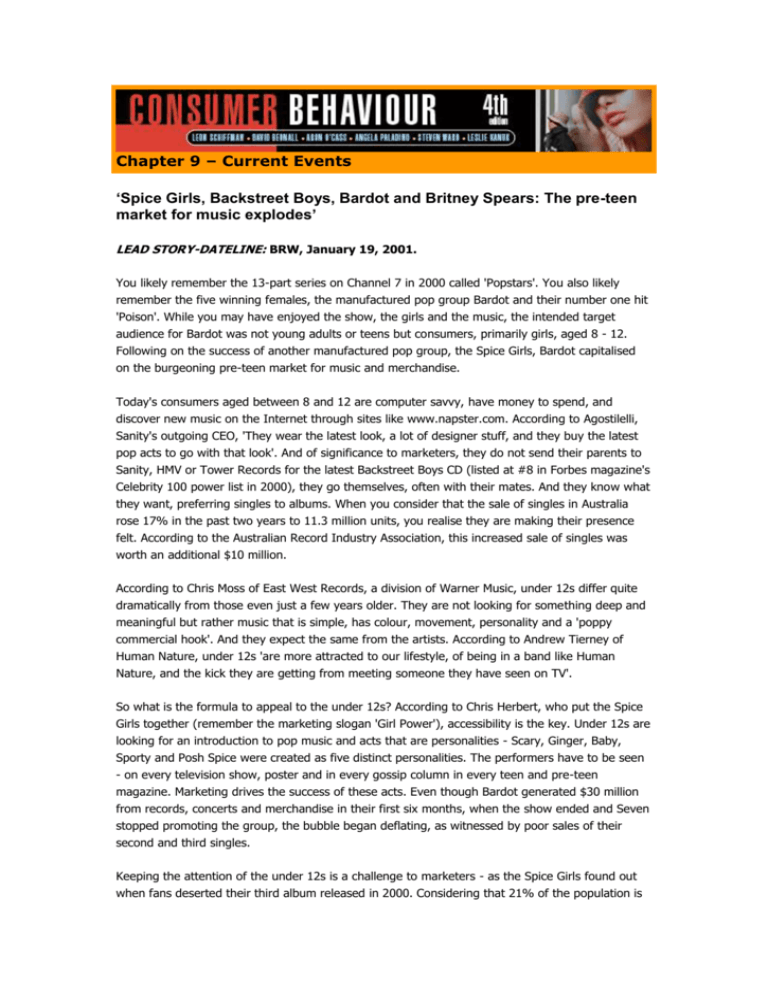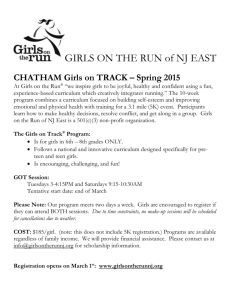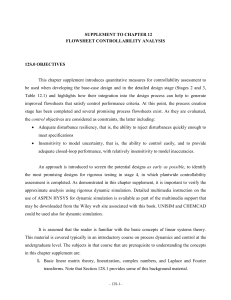The pre-teen market for music explodes
advertisement

Chapter 9 – Current Events ‘Spice Girls, Backstreet Boys, Bardot and Britney Spears: The pre-teen market for music explodes’ LEAD STORY-DATELINE: BRW, January 19, 2001. You likely remember the 13-part series on Channel 7 in 2000 called 'Popstars'. You also likely remember the five winning females, the manufactured pop group Bardot and their number one hit 'Poison'. While you may have enjoyed the show, the girls and the music, the intended target audience for Bardot was not young adults or teens but consumers, primarily girls, aged 8 - 12. Following on the success of another manufactured pop group, the Spice Girls, Bardot capitalised on the burgeoning pre-teen market for music and merchandise. Today's consumers aged between 8 and 12 are computer savvy, have money to spend, and discover new music on the Internet through sites like www.napster.com. According to Agostilelli, Sanity's outgoing CEO, 'They wear the latest look, a lot of designer stuff, and they buy the latest pop acts to go with that look'. And of significance to marketers, they do not send their parents to Sanity, HMV or Tower Records for the latest Backstreet Boys CD (listed at #8 in Forbes magazine's Celebrity 100 power list in 2000), they go themselves, often with their mates. And they know what they want, preferring singles to albums. When you consider that the sale of singles in Australia rose 17% in the past two years to 11.3 million units, you realise they are making their presence felt. According to the Australian Record Industry Association, this increased sale of singles was worth an additional $10 million. According to Chris Moss of East West Records, a division of Warner Music, under 12s differ quite dramatically from those even just a few years older. They are not looking for something deep and meaningful but rather music that is simple, has colour, movement, personality and a 'poppy commercial hook'. And they expect the same from the artists. According to Andrew Tierney of Human Nature, under 12s 'are more attracted to our lifestyle, of being in a band like Human Nature, and the kick they are getting from meeting someone they have seen on TV'. So what is the formula to appeal to the under 12s? According to Chris Herbert, who put the Spice Girls together (remember the marketing slogan 'Girl Power'), accessibility is the key. Under 12s are looking for an introduction to pop music and acts that are personalities - Scary, Ginger, Baby, Sporty and Posh Spice were created as five distinct personalities. The performers have to be seen - on every television show, poster and in every gossip column in every teen and pre-teen magazine. Marketing drives the success of these acts. Even though Bardot generated $30 million from records, concerts and merchandise in their first six months, when the show ended and Seven stopped promoting the group, the bubble began deflating, as witnessed by poor sales of their second and third singles. Keeping the attention of the under 12s is a challenge to marketers - as the Spice Girls found out when fans deserted their third album released in 2000. Considering that 21% of the population is aged under 15 according to the Australian Bureau of Statistics, it would be expected that these consumers are faced with a myriad of products competing for their dollars. Sanity uses continually changing bright colours in their stores to attract pre-teens and are giving increasing shelf space to the singles preferred by the under 12s - the average store now devotes four metres of wall space to singles, compared to half a metre a few years ago. Universal Music established a web site specifically designed for pre-teens with the intention that the bigger pop acts would draw the traffic so that newer acts could be introduced. The site attracted over 600,000 hits in October 2000 alone. Music companies advertise heavily in magazines such as Barbie, aimed at 5 - 12 year old girls. And the toy industry has realised the potential of alliances with the music industry witness the Britney Spears doll and the fact that there was a 20% growth in sales of slinkies after the toy appeared in Powderfinger's 'My Happiness' video. TALKING IT OVER AND THINKING IT THROUGH 1. Discuss the challenges faced by marketers in appealing to under 12s. 2. Discuss the opportunities faced by marketers in appealing to under 12s. 3. Visit the following web sites: o o o the Spice Girls Official Site at www.virginrecords.com/spicegirls/ the Backstreet Boys Official Site at www.Backstreetboys.com the Westlife Official Site at www.westlife.co.uk/ What evidence do you see that these groups are specifically appealing to the under 12s? 4. Visit the following web sites: o Tower Records at www.towerrecords.com o Virgin Records at www.vmg.co.uk o Sanity at www.sanity.com.au What evidence do you see that these companies are specifically appealing to the under 12s? THINKING ABOUT THE FUTURE! Form a discussion group with family and friends. Select one group that currently specifically appeals to the under 12 market. Select another 'up and coming' Australian group that you believe would appeal to the under 12 market. Regularly review the web sites of the established group to see what they are doing to maintain their appeal to the under 12s. For the 'up and coming' group, watch their progress to see if they are 'following the formula' - for example, appearing on TV programs or in magazines specifically targeted to the under 12s. DIGGING DEEPER! ‘Stealing our copyright provisions in the dead of night when no one is looking is piracy. It's not piracy when kids swap music over the Internet using Napster.’ Courtney Love of Hole ‘... it's cool to share music as long as no one is making money from the process...'. Bono of U2 How do you think the music industry will respond to technological advances such as CD burners and computer software that allows anyone to download music for free? Do you think the opinions of artists such as Love and Bono may change in the future? If so, why; if not, why not? What is your opinion about the legal and ethical issues surrounding Napster and MP3? SOURCE: 'Music: Pre-teens rule the pop world', BRW, January 19, 2001 Jan Charbonneau








